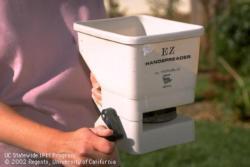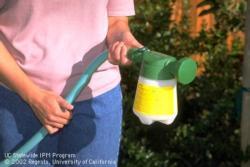Garden soils are rarely fertile enough to supply all of the nutrients required for the best growth of plants. Nitrogen is naturally low in almost all California soils, and soil in many regions of the state is also low in phosphorus, so these nutrients should be added to the soil before planting. Most California soils have adequate amounts of other essential plant nutrients, but poor growth of vegetables and other plants may indicate a deficiency of one or more nutrients. Soil tests, or consultation with a Master Gardener, can help you decide whether other nutrients are needed.
By law, the guaranteed content of a fertilizer must be printed on the bag or box. The first number shown is the percentage of Nitrogen (N), the second is the percentage of Phosphorus (P) and the third is the percentage of Potassium (K). A 100-pound bag of 12-12-12 grade fertilizer contains 12 pounds each of N, P and K. The other 64 pounds in the bag is filler, which facilitates even spreading of the fertilizer.
There are many types of fertilizers available. There are commercially available inorganic fertilizers which are characteristically fast-acting and relatively low in cost. Because inorganic fertilizers are salts, key disadvantages are their potential to leach and burn crops if mismanaged. There are also organic fertilizers, such as manures, which are generally more slowly released, contain many of the essential nutrients required for plant growth and development, and also improve soil structure. Their principal limitations are their bulk, availability, odor, potential for weed seeds, and expense. When applying either organic fertilizers or inorganic fertilizers, use them efficiently to reduce cost, prevent plant injury and to prevent unwanted changes in the environment.
Fertilizer application methods, rates and timing should be matched to the nutritional needs of particular plants and to the nutrient deficiencies of the soil. The broadcast method of applying fertilizer, which is effective for large lawn areas or garden plots, consists of uniformly distributing dry or liquid fertilizer onto the soil surface. Many home gardeners use a drop spreader to facilitate uniform application of dry fertilizer. Be sure to sweep up any fertilizer that gets onto walkways or patios so that it does not run off into water ways.
Fertilizers may also be “banded” at planting time rather than being broadcast and worked into the soil. To band fertilizer, determine where seeds are to be planted and dig a shallow trench 2-4 inches to one side and 2-4 inches below where the seed is to be placed. Distribute fertilizer evenly in the bottom of the trench and cover with soil before seeding. After plants are established, a “side-dressing” with nitrogen can be very effective. Side-dressing is the application of dry fertilizer beside actively growing plants to replace nutrients that have been leached or used up in the growth process. The trench should be at least 4 inches from the side and below the plant row to prevent burning the roots. Do not side dress with large amounts of nitrogen after vegetable plants have begun to mature because the fertilizer will encourage vegetative growth at the expense of fruiting.



